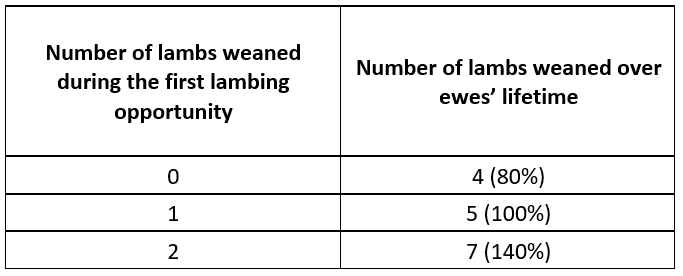Estimated reading time: 6 minutes
Intensive sheep production involves the manipulation of the ewe flock’s production environment in a way that maximises production per ewe. Emphasis is placed on improved nutrition and accelerated, more intensive lambing systems.
Producers often jump the gun, intensifying their sheep production operation without the necessary management skills, while using a ewe flock that is unable to respond to the upgraded environment. These producers expect results without first getting to grips with the basic aspects of good flock- and nutrition management.
Find out how to choose the best sheep farming system for your farm.
For an intensive sheep production operation to be successful, the starting point is always precision farming and maximum profit – not maximum reproduction and turnover. Sheep producers should only consider intensifying their operation when they are already farming the right flock, possess the necessary management skills and infrastructure, and have mastered the basic management tasks. Until then, the emphasis should be on precision farming.
The rules of precision farming
Precision farming requires a thorough understanding of those production factors and inputs that lead to optimal production and maximum profit, as well as managing, measuring and evaluating them while making timely adjustments where necessary. Hence, it is essentially a systems approach where all factors determining the success of the system are reconciled with one other, and of which intensification can be a part.
Read more about John Becker’s success with precision farming.
The first rule of precision sheep farming is the sustainable management of veld in good condition and maintaining a livestock load that is in harmony with the farm’s carrying capacity. The second rule advocates a breeding flock that conceives regularly and without difficulty under their specific environmental conditions, that successfully completes their gestation periods, produces problem-free, viable and healthy lambs, and successfully raises and weans their lambs.
The third rule constitutes the pursuit of maximum profit.
Veld and flock management
Every sheep flock has breeding animals that conceive regularly, complete their gestation periods, lamb without problems, and raise their lambs well. Similarly, each flock has breeding ewes that produce only a few or no offspring. The secret to building a reproductively efficient breeding flock is to timeously identify poor performers and remove them from the flock.
Research from around the globe shows a strong link between breeding ewes’ reproductive performance during their first reproductive cycle and their lifetime reproductive performance. Replacement ewes that conceive easily during their first lambing opportunity will do so over their lifetime, and vice versa.
During the 1990s, 15 wool producers participated in a ewe project on the farm Groenvlei in the Graaff-Reinet district. Each participant supplied ten ewes – 150 in total – which were kept in one flock for the remainder of their reproductive lives, and were managed in the same way.
The entire flock was artificially inseminated with one ram’s semen in autumn each year, with the ewes running with follow up rams for another 34 days afterwards. Each ewe had five lambing opportunities over her lifetime. They lambed on pastures in September each year, and the lambs were weaned in February. It was possible to identify top-quality ewes during the first lambing opportunity (Table 1). Those which skipped in their first year, skipped again at least once thereafter.

Profitable reproduction
Livestock producers are generally under the impression that an optimally producing flock makes the most profit. Although the concept of marginality (or diminishing returns) is well-known among producers, they often still fall victim to its effect.
Maximum return does not necessarily lead to maximum profit. In fact, where livestock production is concerned, maximum profit is usually realised at yields that are lower than the maximum yield. Producers are often advised to increase production per animal, whereas the recommendation is rather to produce more economically and more per hectare.
Once the cost to maximise production exceeds the associated increase in income, producers are entering dangerous territory. This is the result when one blindly tries to drive up the flock’s reproduction rates as much as possible.
The bigger the difference between an input cost (for example creep feed) and the yield the cost brings (for example meat income), the closer the maximum profit is to the maximum yield. The converse is also true and is known as the law of diminishing marginal returns. The smaller the difference between input costs and returns, the smaller the chance of turning a profit.
This relative relationship between product prices and input costs is constantly fluctuating. A practice that maximises profit one year will not necessarily yield the same profit the next year. For example, if the price of creep feed rises faster from year 1 to year 2 than the A-grade lamb price, the level at which creep feed drives up profits will be lower in year 2 than in year 1.
Practical guidelines
The practical significance of the principle of marginality for livestock producers includes the following:
- Pursue maximum profit per hectare and not maximum yield per animal.
- Inputs must be applied economically. The strategic use of nutrition is an excellent example. Lambs’ feed conversion capacity decreases as they age. So, the sooner they are given creep feed, the better their profitability. Creep feeding should also be stopped before the stage when the lamb no longer grows profitably.
- Be careful not to establish a flock that depends on price-sensitive inputs, as the farming operation’s profits can come under pressure in years when those inputs are expensive.
- Refine your input cost management. Get the best prices and compare product prices based on each product’s content. For example, different licks should not be compared on a kilogram-by-kilogram basis, but rather according to the kilogram of protein each lick contains.
- Certain production practices deliver better marginal yields than others; for example, creep feed for lambs younger than 30 days compared to lambs older than 60 days. Likewise, there are times during the reproduction year of breeding animals when some inputs deliver better marginal yields than at other times. For example, it makes sense to improve ewes’ condition during their third trimester, rather than to neglect them during gestation and then attempt to save the situation once they’ve lambed – the damage is done, and no nutrition programme will reverse it.
- Deliver top quality products for which there is a strong market and for which top prices are paid. Brush up your marketing management and do not accept the first price offered. Enter the marketing chain where possible and take advantage of opportunities for vertical integration.
- Analyse the economic and biological performance of the farming operation annually, and identify those aspects that impede profits.
- Do not follow a universal approach to profit-making. What works this year might be unaffordable the next.
- The existence of marginality requires the modern livestock producer to apply precision farming. Therefore, determine where the best return for each R1 of input cost is obtained. – Dr Louis du Pisani, independent agricultural consultant
For more information and references, contact Dr Louis du Pisani on 082 773 9778 or Ldupisani@gmail.com.







